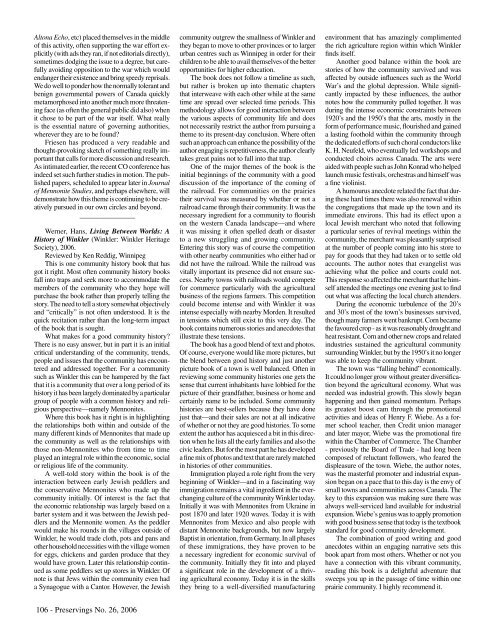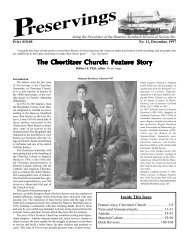Preservings $20 Issue No. 26, 2006 - Home at Plett Foundation
Preservings $20 Issue No. 26, 2006 - Home at Plett Foundation
Preservings $20 Issue No. 26, 2006 - Home at Plett Foundation
Create successful ePaper yourself
Turn your PDF publications into a flip-book with our unique Google optimized e-Paper software.
Altona Echo, etc) placed themselves in the middle<br />
of this activity, often supporting the war effort explicitly<br />
(with ads they ran, if not editorials directly),<br />
sometimes dodging the issue to a degree, but carefully<br />
avoiding opposition to the war which would<br />
endanger their existence and bring speedy reprisals.<br />
We do well to ponder how the normally tolerant and<br />
benign governmental powers of Canada quickly<br />
metamorphosed into another much more thre<strong>at</strong>ening<br />
face (as often the general public did also) when<br />
it chose to be part of the war itself. Wh<strong>at</strong> really<br />
is the essential n<strong>at</strong>ure of governing authorities,<br />
wherever they are to be found?<br />
Friesen has produced a very readable and<br />
thought-provoking sketch of something really important<br />
th<strong>at</strong> calls for more discussion and research.<br />
As intim<strong>at</strong>ed earlier, the recent CO conference has<br />
indeed set such further studies in motion. The published<br />
papers, scheduled to appear l<strong>at</strong>er in Journal<br />
of Mennonite Studies, and perhaps elsewhere, will<br />
demonstr<strong>at</strong>e how this theme is continuing to be cre<strong>at</strong>ively<br />
pursued in our own circles and beyond.<br />
________________<br />
Werner, Hans, Living Between Worlds: A<br />
History of Winkler (Winkler: Winkler Heritage<br />
Society), <strong>2006</strong>.<br />
Reviewed by Ken Reddig, Winnipeg<br />
This is one community history book th<strong>at</strong> has<br />
got it right. Most often community history books<br />
fall into traps and seek more to accommod<strong>at</strong>e the<br />
members of the community who they hope will<br />
purchase the book r<strong>at</strong>her than properly telling the<br />
story. The need to tell a story somewh<strong>at</strong> objectively<br />
and “critically” is not often understood. It is the<br />
quick recit<strong>at</strong>ion r<strong>at</strong>her than the long-term impact<br />
of the book th<strong>at</strong> is sought.<br />
Wh<strong>at</strong> makes for a good community history?<br />
There is no easy answer, but in part it is an initial<br />
critical understanding of the community, trends,<br />
people and issues th<strong>at</strong> the community has encountered<br />
and addressed together. For a community<br />
such as Winkler this can be hampered by the fact<br />
th<strong>at</strong> it is a community th<strong>at</strong> over a long period of its<br />
history it has been largely domin<strong>at</strong>ed by a particular<br />
group of people with a common history and religious<br />
perspective—namely Mennonites.<br />
Where this book has it right is in highlighting<br />
the rel<strong>at</strong>ionships both within and outside of the<br />
many different kinds of Mennonites th<strong>at</strong> made up<br />
the community as well as the rel<strong>at</strong>ionships with<br />
those non-Mennonites who from time to time<br />
played an integral role within the economic, social<br />
or religious life of the community.<br />
A well-told story within the book is of the<br />
interaction between early Jewish peddlers and<br />
the conserv<strong>at</strong>ive Mennonites who made up the<br />
community initially. Of interest is the fact th<strong>at</strong><br />
the economic rel<strong>at</strong>ionship was largely based on a<br />
barter system and it was between the Jewish peddlers<br />
and the Mennonite women. As the peddler<br />
would make his rounds in the villages outside of<br />
Winkler, he would trade cloth, pots and pans and<br />
other household necessities with the village women<br />
for eggs, chickens and garden produce th<strong>at</strong> they<br />
would have grown. L<strong>at</strong>er this rel<strong>at</strong>ionship continued<br />
as some peddlers set up stores in Winkler. Of<br />
note is th<strong>at</strong> Jews within the community even had<br />
a Synagogue with a Cantor. However, the Jewish<br />
community outgrew the smallness of Winkler and<br />
they began to move to other provinces or to larger<br />
urban centres such as Winnipeg in order for their<br />
children to be able to avail themselves of the better<br />
opportunities for higher educ<strong>at</strong>ion.<br />
The book does not follow a timeline as such,<br />
but r<strong>at</strong>her is broken up into them<strong>at</strong>ic chapters<br />
th<strong>at</strong> interweave with each other while <strong>at</strong> the same<br />
time are spread over selected time periods. This<br />
methodology allows for good interaction between<br />
the various aspects of community life and does<br />
not necessarily restrict the author from pursuing a<br />
theme to its present-day conclusion. Where often<br />
such an approach can enhance the possibility of the<br />
author engaging is repetitiveness, the author clearly<br />
takes gre<strong>at</strong> pains not to fall into th<strong>at</strong> trap.<br />
One of the major themes of the book is the<br />
initial beginnings of the community with a good<br />
discussion of the importance of the coming of<br />
the railroad. For communities on the prairies<br />
their survival was measured by whether or not a<br />
railroad came through their community. It was the<br />
necessary ingredient for a community to flourish<br />
on the western Canada landscape—and where<br />
it was missing it often spelled de<strong>at</strong>h or disaster<br />
to a new struggling and growing community.<br />
Entering this story was of course the competition<br />
with other nearby communities who either had or<br />
did not have the railroad. While the railroad was<br />
vitally important its presence did not ensure success.<br />
Nearby towns with railroads would compete<br />
for commerce particularly with the agricultural<br />
business of the regions farmers. This competition<br />
could become intense and with Winkler it was<br />
intense especially with nearby Morden. It resulted<br />
in tensions which still exist to this very day. The<br />
book contains numerous stories and anecdotes th<strong>at</strong><br />
illustr<strong>at</strong>e these tensions.<br />
The book has a good blend of text and photos.<br />
Of course, everyone would like more pictures, but<br />
the blend between good history and just another<br />
picture book of a town is well balanced. Often in<br />
reviewing some community histories one gets the<br />
sense th<strong>at</strong> current inhabitants have lobbied for the<br />
picture of their grandf<strong>at</strong>her, business or home and<br />
certainly name to be included. Some community<br />
histories are best-sellers because they have done<br />
just th<strong>at</strong>—and their sales are not <strong>at</strong> all indic<strong>at</strong>ive<br />
of whether or not they are good histories. To some<br />
extent the author has acquiesced a bit in this direction<br />
when he lists all the early families and also the<br />
civic leaders. But for the most part he has developed<br />
a fine mix of photos and text th<strong>at</strong> are rarely m<strong>at</strong>ched<br />
in histories of other communities.<br />
Immigr<strong>at</strong>ion played a role right from the very<br />
beginning of Winkler—and in a fascin<strong>at</strong>ing way<br />
immigr<strong>at</strong>ion remains a vital ingredient in the everchanging<br />
culture of the community Winkler today.<br />
Initially it was with Mennonites from Ukraine in<br />
post 1870 and l<strong>at</strong>er 1920 waves. Today it is with<br />
Mennonites from Mexico and also people with<br />
distant Mennonite backgrounds, but now largely<br />
Baptist in orient<strong>at</strong>ion, from Germany. In all phases<br />
of these immigr<strong>at</strong>ions, they have proven to be<br />
a necessary ingredient for economic survival of<br />
the community. Initially they fit into and played<br />
a significant role in the development of a thriving<br />
agricultural economy. Today it is in the skills<br />
they bring to a well-diversified manufacturing<br />
environment th<strong>at</strong> has amazingly complimented<br />
the rich agriculture region within which Winkler<br />
finds itself.<br />
Another good balance within the book are<br />
stories of how the community survived and was<br />
affected by outside influences such as the World<br />
War’s and the global depression. While significantly<br />
impacted by these influences, the author<br />
notes how the community pulled together. It was<br />
during the intense economic constraints between<br />
1920’s and the 1950’s th<strong>at</strong> the arts, mostly in the<br />
form of performance music, flourished and gained<br />
a lasting foothold within the community through<br />
the dedic<strong>at</strong>ed efforts of such choral conductors like<br />
K. H. Neufeld, who eventually led workshops and<br />
conducted choirs across Canada. The arts were<br />
aided with people such as John Konrad who helped<br />
launch music festivals, orchestras and himself was<br />
a fine violinist.<br />
A humourus anecdote rel<strong>at</strong>ed the fact th<strong>at</strong> during<br />
these hard times there was also renewal within<br />
the congreg<strong>at</strong>ions th<strong>at</strong> made up the town and its<br />
immedi<strong>at</strong>e environs. This had its effect upon a<br />
local Jewish merchant who noted th<strong>at</strong> following<br />
a particular series of revival meetings within the<br />
community, the merchant was pleasantly surprised<br />
<strong>at</strong> the number of people coming into his store to<br />
pay for goods th<strong>at</strong> they had taken or to settle old<br />
accounts. The author notes th<strong>at</strong> evangelist was<br />
achieving wh<strong>at</strong> the police and courts could not.<br />
This response so affected the merchant th<strong>at</strong> he himself<br />
<strong>at</strong>tended the meetings one evening just to find<br />
out wh<strong>at</strong> was affecting the local church <strong>at</strong>tenders.<br />
During the economic turbulence of the 20’s<br />
and 30’s most of the town’s businesses survived,<br />
though many farmers went bankrupt. Corn became<br />
the favoured crop - as it was reasonably drought and<br />
he<strong>at</strong> resistant. Corn and other new crops and rel<strong>at</strong>ed<br />
industries sustained the agricultural community<br />
surrounding Winkler, but by the 1950’s it no longer<br />
was able to keep the community vibrant.<br />
The town was “falling behind” economically.<br />
It could no longer grow without gre<strong>at</strong>er diversific<strong>at</strong>ion<br />
beyond the agricultural economy. Wh<strong>at</strong> was<br />
needed was industrial growth. This slowly began<br />
happening and then gained momentum. Perhaps<br />
its gre<strong>at</strong>est boost cam through the promotional<br />
activities and ideas of Henry F. Wiebe. As a former<br />
school teacher, then Credit union manager<br />
and l<strong>at</strong>er mayor, Wiebe was the promotional fire<br />
within the Chamber of Commerce. The Chamber<br />
- previously the Board of Trade - had long been<br />
composed of reluctant followers, who feared the<br />
displeasure of the town. Wiebe, the author notes,<br />
was the masterful promoter and industrial expansion<br />
began on a pace th<strong>at</strong> to this day is the envy of<br />
small towns and communities across Canada. The<br />
key to this expansion was making sure there was<br />
always well-serviced land available for industrial<br />
expansion. Wiebe’s genius was to apply promotion<br />
with good business sense th<strong>at</strong> today is the textbook<br />
standard for good community development.<br />
The combin<strong>at</strong>ion of good writing and good<br />
anecdotes within an engaging narr<strong>at</strong>ive sets this<br />
book apart from most others. Whether or not you<br />
have a connection with this vibrant community,<br />
reading this book is a delightful adventure th<strong>at</strong><br />
sweeps you up in the passage of time within one<br />
prairie community. I highly recommend it.<br />
106 - <strong>Preservings</strong> <strong>No</strong>. <strong>26</strong>, <strong>2006</strong>
















